When my husband Mat and I set off from Sidmouth, England, our destination was the Mediterranean, roughly 870 miles (1,400km) south. We planned to reach it through the inland waterways of France. We had two months off work and arranged for friends to meet us with the boat trailer in the port of Sète on August 5, 2017, to bring us home. We estimated we’d need to row at least six hours every day to make it. With just weeks to go before we planned to depart, Mat finished our boat, DUNLIN. The lapstrake dinghy, 13′ 7″ long with a 4′ 6″ beam, was the first boat he’d built and is based on a traditional workboat designed for both rowing and sailing with a gaff sloop rig.
As our families waved goodbye from Sidmouth beach, we clumsily zigzagged east along the English Channel coast, unable to row in a straight line. We had only rowed DUNLIN together for the first time a few days previously and we weren’t helped by a poor distribution of gear that had disrupted the proper trim. That morning we’d stuffed the tiny lockers with camping gear, a gas stove, a solar panel, some clothes, and emergency canned food, all inside waterproof bags. Stowed under our seats were water bottles, inflatable rollers, and swimming floats, which made cheap, compact fenders.
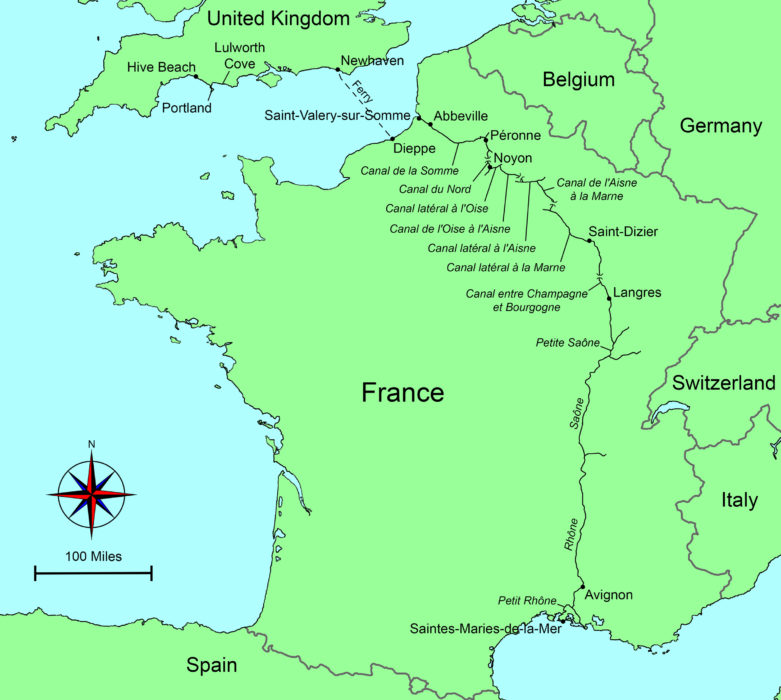 Roger Siebert
Roger Siebert.
With one oar each, we kept practicing in different positions until we settled on Mat to starboard on the aft thwart and me to port on the forward thwart. We eventually learned to keep our strokes rhythmically consistent to row in a straight line. With Mat setting the pace, I had to ensure the blade of my oar would catch the water to start the stroke at exactly the right moment. We counted aloud together, aiming for a long reach and fluid movement. We kept the retractable rudder out of the water while we rowed.
We planned to row as far east as possible before having to put DUNLIN on a ferry for crossing the Channel to France. We had wanted to make it to France ourselves by oar or sail, but found out this would be illegal since the French classified DUNLIN as an “unorthodox vessel” and not permitted to make the crossing
For the first few days along the south coast of Devon and Dorset there was not a breath of wind, so we rowed until we saw somewhere to stop then set up camp on the beach.
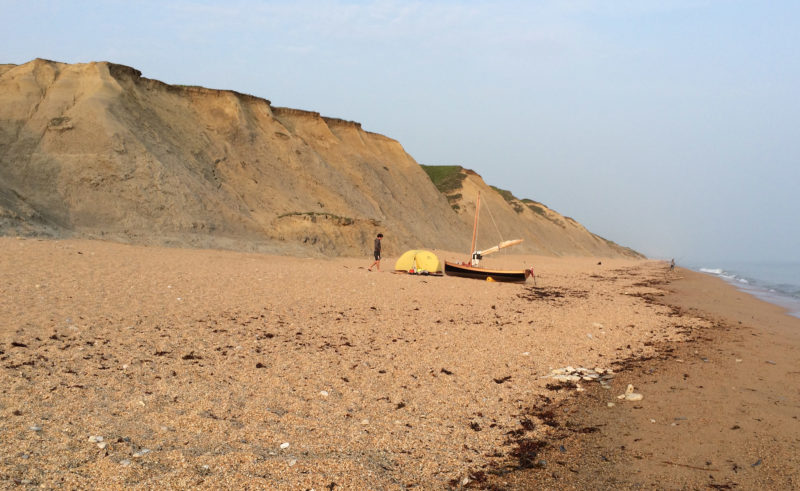 photographs by Polly and Mat Hilton
photographs by Polly and Mat HiltonAt Hive Beach, near Burton Bradstock, Dorset, we used our inflatable boat rollers to push DUNLIN up the beach. We pitched the tent and cooked canned macaroni and cheese on our multi-fuel stove. There weren’t many people on the beach, just us and a few fishermen.
We slept well on Hive Beach, Dorset, and awoke at 6:30 a.m. to a perfectly still day. The sun was warm; there was no chill in the air despite the early hour. We launched DUNLIN and rowed more harmoniously than before as we gained practice, gliding through the glassy sea. We had soon shed layers and felt warm in T-shirts.
We were heading east along the south coast approaching Chesil Beach, an 18-mile-long pebble ridge reaching 40’ high and 175 yards wide. By 7:30 a.m. a Force-3 wind had picked up, rain fell, and we threw on waterproofs and we beat up wind, bashing through gray waves, searching for a spot to land on Chesil beach. Mat had decided we would drag up over the bar of the mountainous shingle beach, sail up through the shallow fleet lagoon behind it, then sneak under the low bridge into Portland Harbour to ensure we could reach a safe place to sleep for the night, instead of wasting hours waiting for the right conditions to go around Portland Bill, a rocky point notorious for its ferocious tidal race.
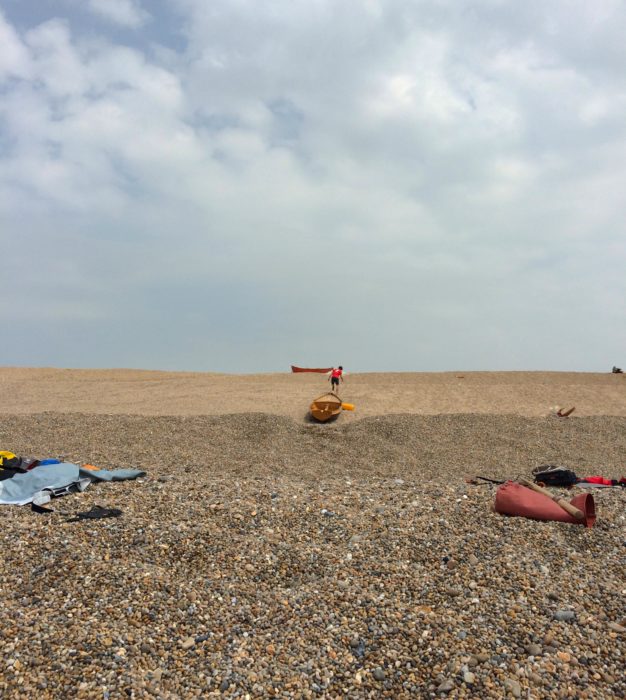
We emptied DUNLIN to reduce the weight before we started heaving her up over Chesil Beach, a pebble and shingle tombolo that connects the Isle of Portland to the mainland. We did the portage to avoid having to face the turbulent waters at Portland Bill at the isle’s southern extremity. We found a shovel to dig holes in the pebbles to bury the anchor and used a makeshift block-and-tackle pulley system to ease the load as we dragged the boat up the beach.
From our position on the water, the landing on Chesil Beach appeared as a vertical, rock solid wall, a few feet high, that we would collide with head-on—not a soft landing. As we sailed closer, it became no less intimidating, so just before we reached it I clumsily hauled myself over the side to avoid collision while Mat landed on the not-quite-vertical ledge.
We spent the next three hours dragging and pushing our quarter-of-a-ton, solid wood boat up and over the steep pebble ridge. We blew up our inflatable boat rollers, and Mat rigged up a block-and-tackle system using the sheets, pulleys, and the anchor. We even found a shovel on the beach, which helped us bury the anchor. The clouds and wind had disappeared and the sun beat down on us again while we slowly, with exhausting effort, pushed DUNLIN 40’ up the steep mound of pebbles. By the time we reached the top we had run out of water to drink and were parched.
Sliding the boat down to the lagoon was easy, and we were soon sailing through the shallows toward what we prayed would be somewhere we could get some water. We landed on a little muddy beach and walked up to a stately Georgian Manor Hotel, where we filled our bottles and gorged on afternoon tea under the shade of a calico umbrella.
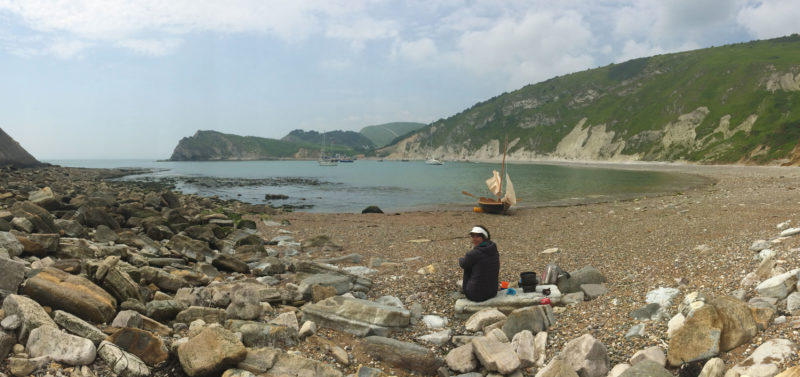
We had a lovely sail around Durdle Door, a hammerhead peninsula on the Dorset coast, and arrived here at Lulworth Cove. Mat’s parents would arrive the following day with DUNLIN’s trailer and drive us to the ferry that would take us across the English Channel. We camped on the beach opposite the village of West Lulworth, expecting to have a quiet stay, but an Army firing range was active through much of the night and made too much noise for us to sleep.
The next day we rowed and sailed to Lulworth Cove, a quarter-mile wide natural harbor, where we rendezvoused with Mat’s parents, Gill and Dave, who drove us, with DUNLIN on the trailer, to the ferry landing at Newhaven.
After the four-hour crossing of the English Channel, the ferry dropped us in France at Dieppe. Gill and Dave drove us to Saint-Valery-sur-Somme, a village at the head of the Baie de la Somme where we found the first spot we could launch into the canalized river. It was flooded and fast-flowing. We had to fight against the current and made painfully slow progress rowing as hard as we could.
After a few hours’ rowing we made it to Abbeville, made a right turn, and headed to our first lock. Floodwater spilled violently over the gates. There was no lock keeper around. A local explained in broken English that the locks were closed because of flooding. We rowed back to the river up a dead-end toward the town center and docked against a towering old ship’s wall. A rusty ladder gave access to the street. It was getting dark, and this was no place for putting up the little tent we’d slept in on the beaches, so we pulled out the boat tent.
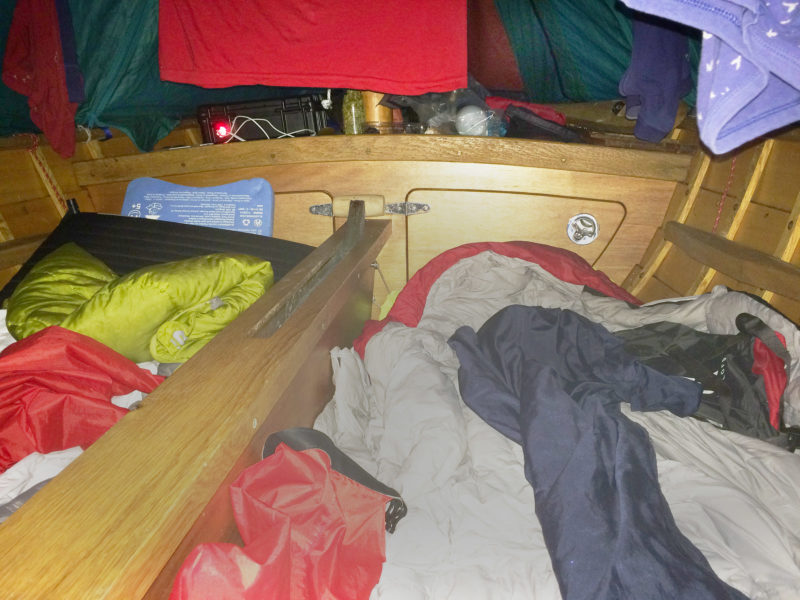
Our sleeping arrangements aboard DUNLIN under the boat tent were quite snug but we usually slept well. Mat made all of the thwarts removable so that we could take them out at night and lie on either side of the centerboard. We both had inflatable sleeping pads and good sleeping bags, which we stored in waterproof bags in the lockers during the day. There was no space for pillows. Clothes that got wet in the rain would hang overnight above us.
In the days before our departure Mat had raided his parent’s attic, where he found an ancient tent and set to it with scissors and a sewing machine. He reshaped it to fit snugly over the top of DUNLIN, with the poles hooking into clips he attached to the gunwales, and with Velcro doors at both ends. The mast had to be in place to put it up, so Mat would balance precariously on the tiny foredeck while I directed the foot of the mast into the step. With the cockpit covered, we settled into our coffin-like beds in the bilges, which were surprisingly comfortable once inside a sleeping bag on a pad.
When we woke from the first sleep aboard DUNLIN we heard the hiss of rain outside. We headed to Abbeville tourist office with Mat’s parents, who had slept in their campervan, knowing they would need to help us get past the flooded locks.
We were told we’d have to row back to Saint-Valery-sur-Somme where we had launched DUNLIN the previous day. Though it was disheartening to go back over previously covered ground, it was a rapid passage aided by the flow of floodwater. The four of us hauled DUNLIN out on to the trailer, drove upstream past the closed locks to the village of Long, 11 miles to the southeast, and launched where the canal was open.
Gill and Dave headed home with the trailer.
Mat and I spent the next week rowing 80 miles against the strong current of the Somme. I slathered my hands in Gurney Goo—a parting gift from my mum—which helped keep blisters away.
At the slightest hint of wind, Mat would hustle to put down his oars, grab the mast (which lay between us while we rowed), and teeter on the foredeck trying to put it in place, then unpack the sails and rigging from the lockers, and get everything ready to sail, while I took both oars and rowed alone against the current.
The wind was always too short-lived to make any progress under sail. The waterway was lined with trees, which allowed the occasional gust but sheltered us from most wind. We would pick up our oars again and row with the sails up and I’d bang the back of my head on the mast at the end of every stroke until we took it all down again.
When we reached Péronne, the pastoral, serpentine Somme joined the canal du Nord, a busy, often arrow-straight, 59-mile-long commercial waterway carrying hundreds of péniches—huge commercial barges, some weighing thousands of tons. It was our only route to the Med; the way to the alternative route via the Canal de Saint Quentin was closed, and in need of restoration.
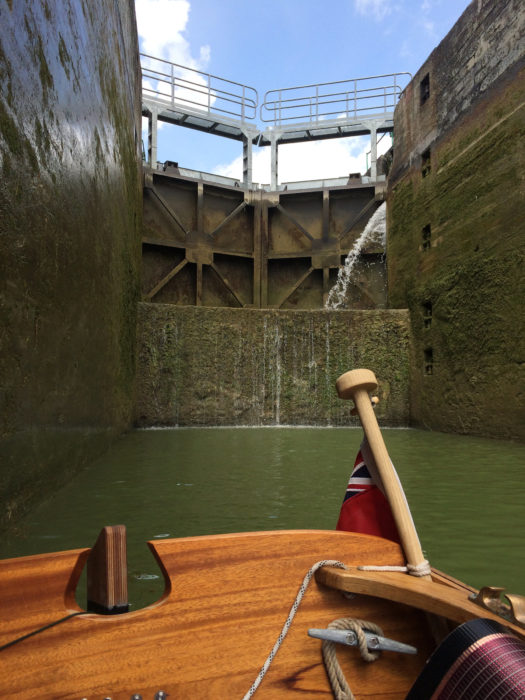
Each new canal had a new type of lock to get used to. This is one of the smaller locks on the waterways in the north. On one series of locks you’re accompanied by a youngster on a moped, usually a female student, who rides along the towpath and works the locks ahead of you. This was a luxury.
Violent thunderstorms and heavy rain began to arrive daily. On a supply run to a grocery store in Noyon we saw newspaper headlines: “Storms & heavy rain batter continent,” “More than 330,000 lightning strikes hit Europe in just eight hours,” “Extreme lightning strikes, killing and seriously injuring dozens of people.”
We spent the next 12 days dodging thunderstorms, rowing 120 miles southward on a network of canals: Canal du Nord, Canal de l’Oise à l’Aisne, Canal lateral l’Oise a l’Aisne, Canal de l’Aisne à la Marne, and Canal lateral à la Marne.
Near Saint-Christ-Briost, on the Canal du Nord, we spotted a place we could moor just as tar-black storm clouds darkened the sky. We hastily erected our little yellow tent under a tree on sharp gravel, dotted with dog crap and brown puddles. We dived into the tent as sheets of heavy rain hit the canvas; the noise was so intense we were shouting to hear one another despite being huddled like two Antarctic penguins trying to keep warm. A violent crack of thunder pierced the air around us at the same time that lightning flashed, so intense it burned your eyes before they clamped shut. I flinched every time, certain that lightning so close couldn’t miss us. We huddled for an hour while fierce thunder clapped every few minutes. When the rain eased, we carried on.
We were careful not to get in the way of barges. When big ones overtook us, we could surf the bow waves which sped us forward. On narrow straits, barges approaching from the opposite way pulled the water ahead of them and dragged us toward the wake coming off the bow. We had to row hard to avoid collision.
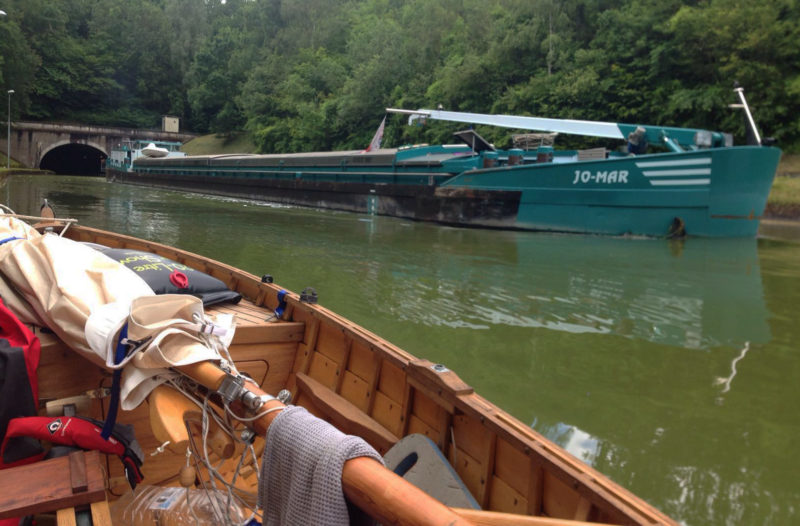
At the 1200-yard-long Panneterie Tunnel on the Canal du Nord, we had to wait our turn while a commercial barge emerged heading in the opposite direction. Many of the tunnels in France are too narrow to allow boats traveling in opposite directions to pass by each other; lock keepers who control a traffic-light system at both ends of the tunnel. It was always a little nerve wracking waiting for a green light to give us the go ahead, since our guide book told us that boats without engines would not be allowed through. But, as we’d hoped, we were given the green light to pass through all four of the tunnels along our route.
The Canal du Nord has no accommodations for pleasure boats, so finding a suitable camp for the night wasn’t easy. The first night we rowed until it was too dark to continue, searching for a suitable place to stop. Sleeping in the boat wouldn’t be safe, as the wake from any passing barge could capsize us while we slept. At about 9 p.m. we had put on headlamps, devised a way to secure the boat to the canal bank using an anchor attached to the bow line, and then tried to decide where to put the tent. The bank sloped toward the canal, then dropped 2′ straight down to the water. Between the canal and a stagnant swamp, humming with insects, on the opposite side, there was even ground about 6′ wide, just enough space to pitch our tent, but tire tracks running along it suggested it was occasionally used as a road. It was dark and drizzling and we were hungry. We put up the tent on the slope, on the edge of the canal, overlapping the tire tracks as little as possible.
We warmed canned dauphinoise potatoes on the camp stove, then turned in and fidgeted on the sloping ground in our sleeping bags until exhaustion forced us to sleep. A few hours later I was awakened abruptly staring straight into the glow of two headlights that illuminated the yellow canvas of our tent as they sped toward us. I thought we were about to be run over, trapped inside the two zipped doors of our tent with no time to escape. I let out a terrified scream that tore through Mat. Still half asleep, he leapt up out of his sleeping bag, wildly thrashing about as if trying to tear his way out of the tent. We were inches from the water’s edge, on the brink of toppling in. My fear of falling into the canal while zipped inside the tent surpassed that of being run over. I yelled at Mat, “Wake up! Wake up!”
The car inched past us just as Mat awoke from his sleepwalking state. He had snapped a tent pole and now the canvas was sagging. The sound of drizzle pattered on the tent and at 3 a.m. we quietly packed up our things and re-pitched our tent on a hummock in the swamp in a dense cloud of insects that swarmed and glowed in the light of our headlamps.
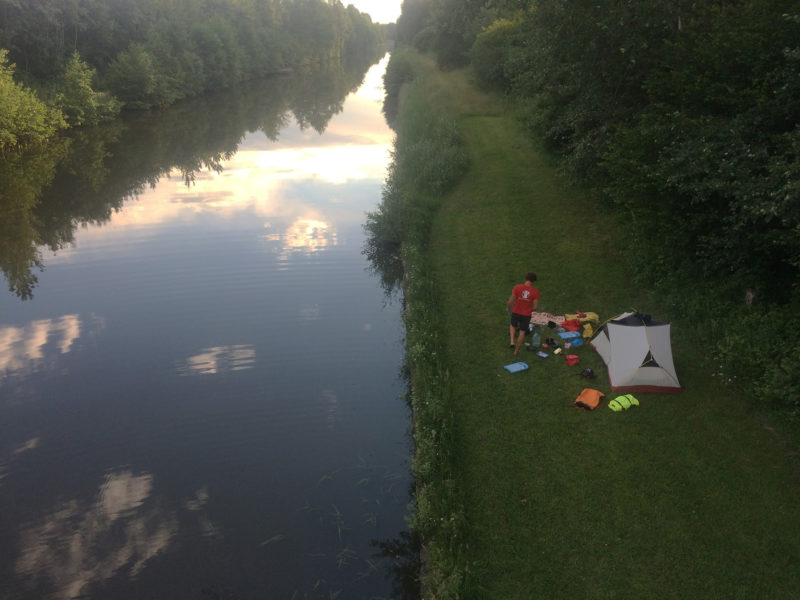
We had not intended to camp here on the Canal de l’Oise à l’Aisne, but its locks are remote-controlled and won’t allow pleasure boats through after 6 pm. We missed getting through the lock (where I was standing to take this photo) by seconds after rowing as hard and fast as we possibly could for the previous hour. We didn’t reach the place with showers or toilets we were aiming for, but this spot was beautiful.
We rowed as fast and long as we could on the Canal du Nord and covered the roughly 27 miles to the Canal de l’Oise à l’Aisne in under three days. After that we usually found places to moor at night. Occasionally we made it to towns on the river with toilets, showers, and Wi-Fi.
We rowed into the Champagne region of northern France, where the murky green-brown water we’d become accustomed to became a translucent, chalky blue. We could see shoals of fish dart and dive to avoid our oars. So far we had passed through over 30 locks, all lifting us higher into the French countryside. We began to see the surrounding hills; a neat patchwork of vineyards, dotted with chateaux.
The Canal de L’Aisne à la Marne carried us up 24 more locks on its 36-mile (58km) length from Berry-au-Bac to Condé-sur-Marne and through the centers of beautiful old cities like Reims and Chalons-en-Champagne. We bought fresh food from bustling markets piled high with brightly colored fruit and vegetables. We explored narrow streets and ate lunch in shaded parks. But sleeping aboard the boat near a city center had its drawbacks. In St-Dizier we were awakened repeatedly by drunks. At around 2 a.m. someone cast off our bowline while we were asleep and we were awakened only when DUNLIN crashed into the quay, tearing a fender. The following morning the lack of sleep didn’t help as we tried to row through thick weeds in the canal. The plants clung to the bow with an enormous dead weight that dragged us to a near halt; it hung in long strands over our oars as we tried to heave them out of the water.
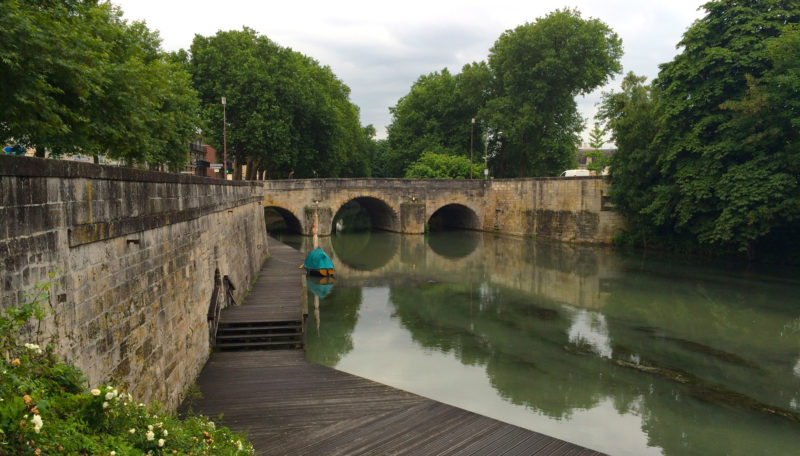
We docked DUNLIN in Châlons-en-Champagne, a city 90 miles due east of Paris. We were able to pass under several low bridges and get right to the city center. It had been raining, so we got the boat tent up as soon as we arrived to give the sleeping area a chance to dry.
We climbed through 71 locks to the summit of the 140-mile-long Canal entre Champagne et Bourgogne. Every day we’d row for nine hours, three of which were spent sitting in locks. They lifted us to an elevation of 1,115’ above sea level, where we arrived at the 134-year-old, 3-mile-long Balesmes Tunnel, near the town of Langres.
We had read that only motor-driven vessels were allowed to pass through tunnels, which were controlled by a traffic-light system. To our relief, we had already been allowed to pass through one such tunnel, so with fingers crossed again we put on our life jackets, switched on our tiny navigation lights, and waited for the red light ahead to turn green…and waited some more. There was no alternative to the tunnel.
Twenty minutes later as we began to lose hope, a double-length péniche came squeezing out of the tunnel, like toothpaste from a tube. We watched as it glided slowly past us. When we looked at the traffic light again we had a green!
The shade of the tunnel was a relief from the heat outside, cold slimy drips fell on us from the ceiling, it was pitch black— no light at the end. When we entered, our boat should have triggered a sensor that turned the lights along the ceiling on, but being so small we’d failed to trigger them. We rummaged around for our headlamps.
About halfway through the tunnel we began to hear the low rumble of a distant engine and smell faint diesel fumes. We were counting aloud to keep our rowing strokes in time, after a month rowing all day, every day we could row in a perfectly straight line. We were both reluctant to disrupt our smooth progress by acknowledging that it smelled and sounded like a péniche was coming toward us. The rumble of the engine grew louder. Just as we thought we would choke on the fumes, we could make out a pale glow at the end of the tunnel. As we rowed closer we could see a maintenance barge but it was only partially obstructing the view out and we’d have room to row around it. We burst past into the hot, bright day and breathed a simultaneous breath of fresh air and sigh of relief. The barge had not been about to motor into the tunnel; it was parked at the entrance, working on reconstructing the façade.
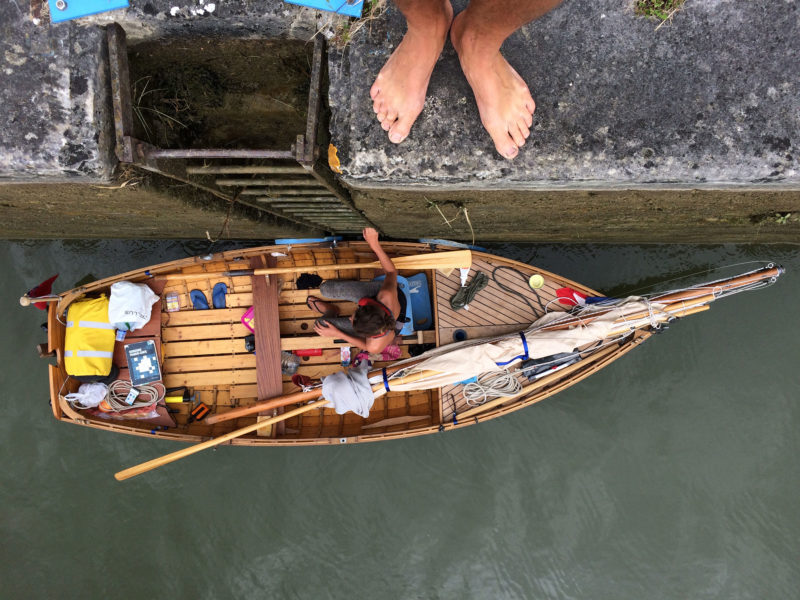
Mat stood on the wall of one of the many small locks we transited while I descended aboard DUNLIN. Dealing with the locks in such a small boat was very easy compared to being in a big, heavy barge, as we could easily hold ourselves in position holding on to the ladders built in to the walls.
With the tunnel behind us we began the downhill leg of the journey. Just 43 more locks until we reached the river flowing to the sea. The remainder of this canal was a series of automated locks. I ran along the bank while Mat rowed so I could manually trigger the sensors that opened and closed the locks because DUNLIN wasn’t substantial enough to trigger them. It was a great relief to be running instead of rowing through the French countryside, passing golden fields dotted with straw bales and white Charolais cows, and picking sweet wild cherries along the way to feast on while we were waiting at the locks.
At the end of the canal we reached the Petite Saone, then the Saone, a wide, open river bustling with rental boats. After weeks of traveling straight, narrow, stagnant canals the feeling of space and fresh water was extremely refreshing. The wind could reach the water, and for the first time since we’d arrived in France, we could sail! We zoomed with ease at twice the speed we had been rowing. It was glorious, but we had to keep an eye out for giant river cruise ships, 360’ long and three stories high, charging up and down the river with their onboard swimming pools and cinemas.
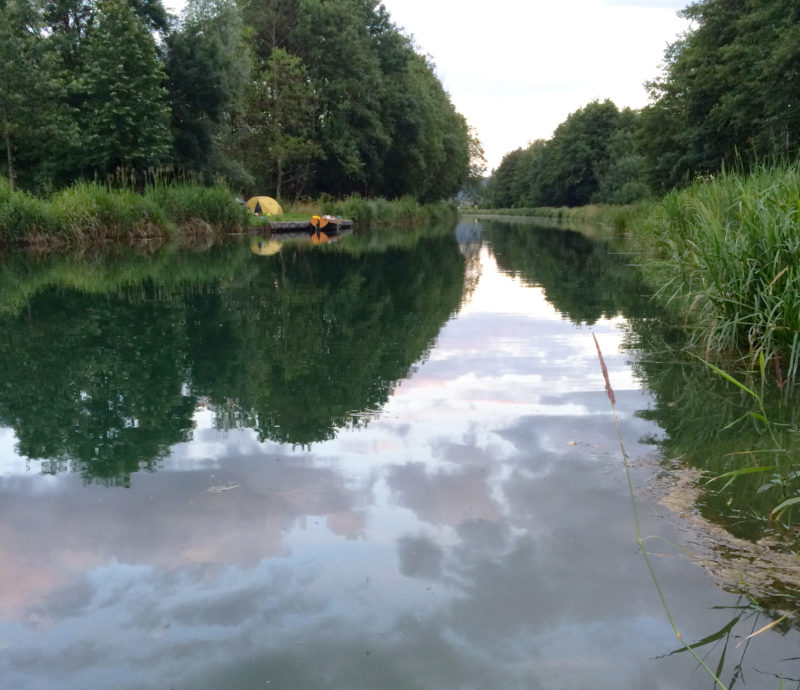
We found this bucolic camping spot on the banks of the Canal Latéral à la Marne, which we joined at Condé-sur-Marne and left at Vitry-le-François, where it joins the Canal entre Champagne et Borgogne. This canal featured very long, straight, relatively uninteresting sections. We passed many péniches that use this route to transport goods from Vitry-le-François to Paris.
We sailed more than we rowed on the 130-mile length of the Saone, sometimes covering over 25 miles a day. The next river, the Rhône, wouldn’t be so accommodating; we had been warned and read that DUNLIN would not be permitted in the locks and on much of the river’s length because we didn’t have an engine. It wasn’t possible to lift DUNLIN past the locks, but we could still make it to the Petite Rhône where we would row out to the sea, if we could find a boat with an engine that was willing to raft DUNLIN alongside to get us past both the locks and through long sections designated as dérivations, on which we were not permitted alone.
A couple of days previously, ashore in Lyon, we had a met Malté and Aladino, two friendly Swiss guys, who were motoring their 30’ sailboat, JULIETTE, to the Med as quickly so they could to sail in Sardinia for the summer. We pulled up onto a slipway at the edge of the Rhône just upriver from the first lock and kept watch over the wide stretch of water. We knew they would pass eventually, and just a couple of hours later we caught sight of JULIETTE. We waved and shouted, leaping about madly to get their attention from 200′ away. Aladino and Malté steered over to us and said they were happy to have us aboard with DUNLIN rafted through the locks and in tow along the dérivations.
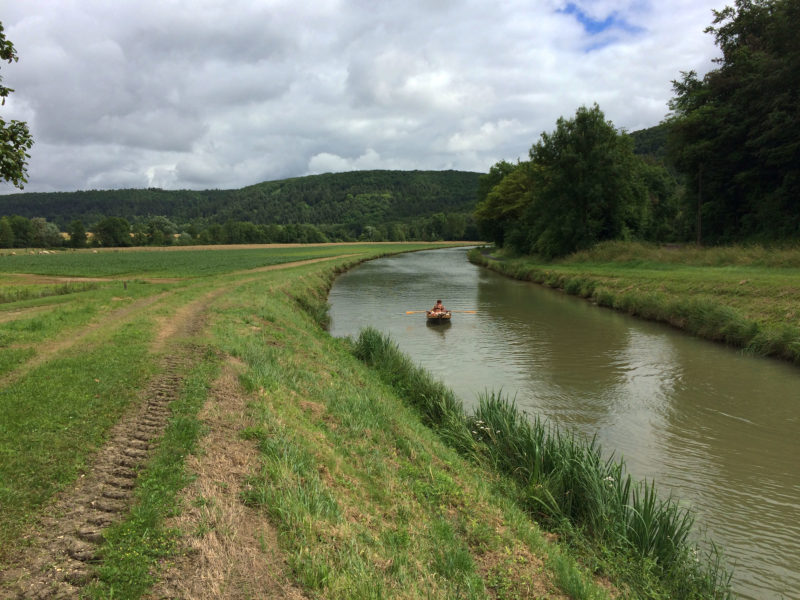
Rowing through the French countryside, we were aiming for the village of Froncles, and a halte fluviale (river stop) that accommodates boaters. Our waterway map indicated it had hot showers. It was just under 20 miles away along the river but we were making slow progress fighting with weeds that tangle our oars for much of that distance. I hopped out on to the bank for a moment to stretch my legs while Mat continued rowing.
Being aboard JULIETTE was good fun but after three long days motoring 150 miles we couldn’t wait to be back aboard DUNLIN, sailing and rowing as we’d planned. Motoring felt like cheating.
With just one more lock on the Rhône separating us from the wild, shallow Petit Rhône, the western arm of the Rhône Delta, Aladino and Malté cast us off. All the motoring put us ahead of schedule, so we decided to row up the arm of the Rhône that leads to the center of the historic city of Avignon. The current was flowing fast, so we tucked into an eddy that helped us make our way upstream. We rowed under the world-famous bridge, the Pont d’Avignon, then spent a day wandering within the city walls and doing chores. The next day, we sailed downstream from Avignon with just the jib on a strong mistral wind for over 10 miles, steering well clear of an 850’ cargo ship and carefully navigating its bow wave.
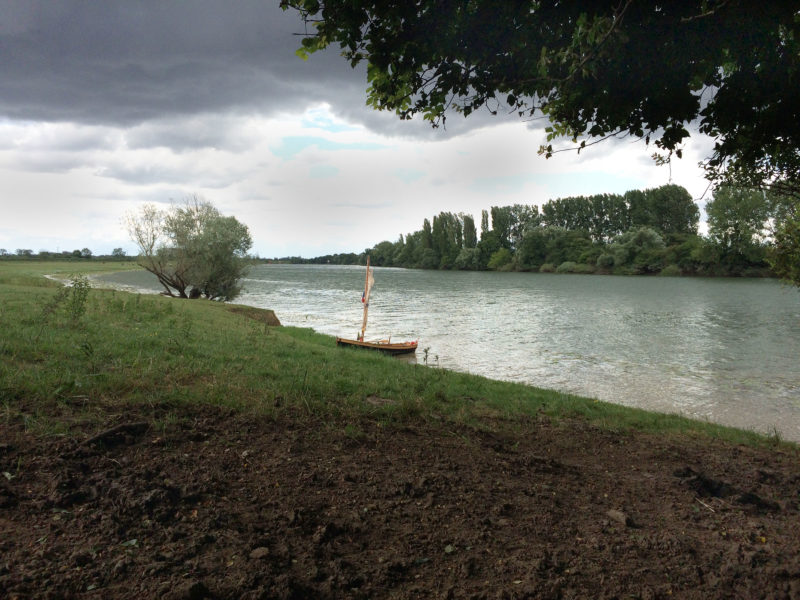
Just downriver from the bustling medieval town of Verdun-sur-le-Doubs, we took shelter under a tree to wait for a storm to pass. DUNLIN sat tied to the bank of the Petite Saone at the edge of a cow pasture. A strong wind was blowing directly against us but the river here was too narrow and too shallow at the edges to tack to weather. We could have taken to the oars, but in the muggy heat we’d get wetter rowing in rain gear than sitting in a thunderstorm, so waiting for the rain to blow over was the best option.
We stopped at a little river port run by a memorable ex–fighter pilot named Olivér. We also met Roger and Mary, a retired Australian couple, who were heading south the following day on their barge. A plan was formed. The next morning, we set sail toward the lock where Roger and Mary caught up with us just before we reached it. They threw us a line. We rafted alongside their 50′ barge without stopping, then climbed aboard. They let Mat take the helm for a while, while I kept an eye on DUNLIN, then reclined on their sofa reading the paper. Mary prepared lunch which we enjoyed while waiting for the lock to open. We passed through smoothly, said thanks and farewell, and jumped back aboard DUNLIN. We had passed through the 202nd and final lock of our journey.
We kept to the right bank and entered the distributary of Petit Rhône. It felt wild and secluded and it was good to be rowing again. It was much narrower than the Rhône and flowing slowly, just a third the speed of the Rhône. We found an idyllic little sandbank to set up camp and lit a fire for cooking and keeping mosquitoes away.
We awoke full of excitement, knowing that roughly less than 30 miles downstream the river spilled into the Mediterranean Sea. Mat relit our campfire and cooked omelets for breakfast while I packed away the camping equipment. After wolfing down omelets, which tasted a lot like wood smoke, we pushed DUNLIN off the sand, jumped in, and continued rowing downstream. There was not a single cloud in the radiant blue sky and the riverbanks, dense with trees, were alive with birdsong.
We rowed hard for 18 miles, with the heat of the Mediterranean sun building. By 1 p.m. we were desperate to find shade and replenish our energy stores. There were no convenient places to stop along the banks, so we grabbed an overhanging branch and tied our bowline to it, then dropped a stern anchor to keep us from swinging under low branches. We refueled on stale baguette and bottled water that had become hot in the sun and tasted strongly of plastic.
When we were ready to get under way again and tried pulling up the anchor, it was stuck. Mat dove in and I watched him swim down until his feet disappeared in to the murky water. He untangled the anchor from roots on the riverbed and we set off toward the Camargue, a marshy lowland island separated from the mainland only by the two slender branches of the Rhône. The river began to widen and groups of tourists paddled past in brightly colored kayaks.
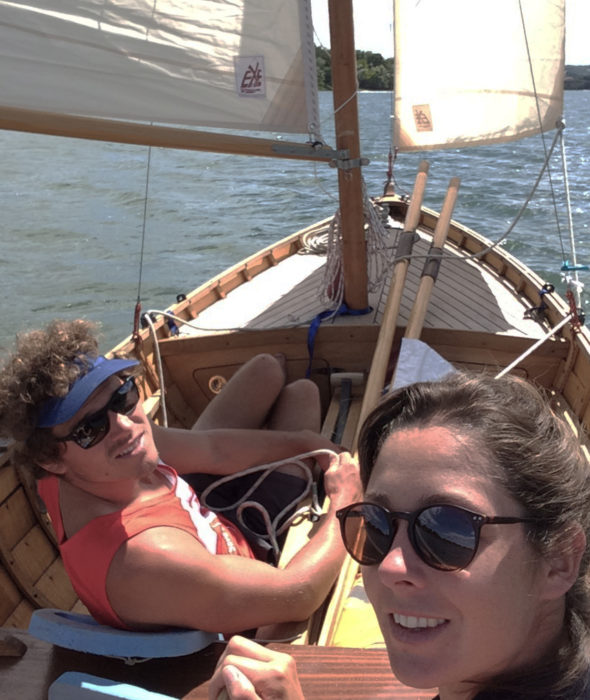
We found perfect sailing conditions on the south-flowing Saone River in east-central France. With the oars are stowed we sailled goose-winged downstream.
Soon after we’d had lunch, a strong breeze picked up, causing a loud rustling in the trees and carrying the smells of hot sand and seawater. Instead of continuing to row directly in to it, we hurriedly stowed the oars, hoisted the sails, and began tacking into the sea breeze. The Mediterranean felt close. DUNLIN was heeling at an unnerving angle, so we leaned out over the windward gunwale as we pushed our way onward. The outhaul block on the boom suddenly came loose and the main flapped wildly. We quickly took down both sails, grabbed the oars, and resumed rowing. After another hour of rowing against the wind, we arrived at vast open plains where wild, white horses and black bulls wandered among grasses, and pink flamingoes on stilt-like legs waded in shallow ponds. Reaching the wetlands of the Camargue felt like rowing into a new continent and promised we were close to the sea.
We rowed around a couple of big meanders, past a charging 60′ paddle cruiser, with a foaming white wake spreading out from its bow, and all of a sudden we could see the sea. The prospect of rowing out into saltwater swell and open sea now seemed a little daunting. For me, a slight panic crept in, but we rowed on, pausing to take in that surreal moment when we were out in the sea looking back up the river. We’d come out at the other end of France! We made it to the Med! The sun was just beginning to sink from view and a pink hue lay along the horizon. We took turns to dive off the boat. The seawater was shockingly cold compared to the warmth of the river we’d become accustomed to bathing and swimming in. When we got back aboard we could feel the salt clinging to our skin.
We had been underway for 52 days since leaving Sidmouth—I had not dared to believe we would actually make it to the Mediterranean. We looked in both directions along the coastline for sign of ports, rechecked our chart, then rowed a mile east through the small, rolling swell to Saintes-Maries-De-La-Mer for the night. We rowed in to Port Gardian, a marina on the west side of the town, and looked for an open spot along the docks among the huge white yachts. The staff didn’t know what to do with us and our tiny wooden boat, they had us move three times before deciding on a place we could stay. Mat rummaged in the locker and pulled out the bottle of champagne we’d bought a month earlier, which we had stowed away for this very moment.![]()
Polly Hilton lives in Devon and founded Find & Foster, a small fine cider company. She has always loved being in and on the water and she kayaked growing up, but was not interested in boats before Mat built DUNLIN and had never sailed before meeting Mat. She has become a keen rower since the trip through France.
If you have an interesting story to tell about your adventures with a small boat, please email us a brief outline and a few photos.
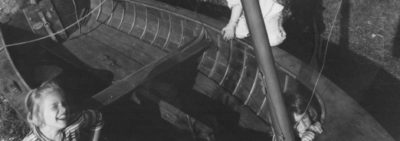
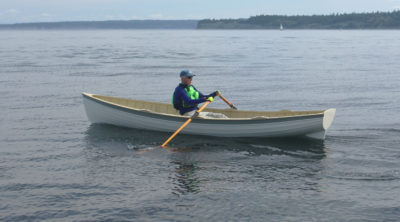

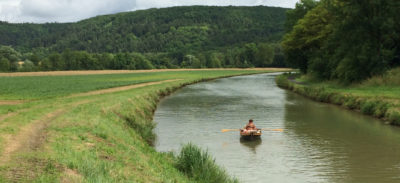

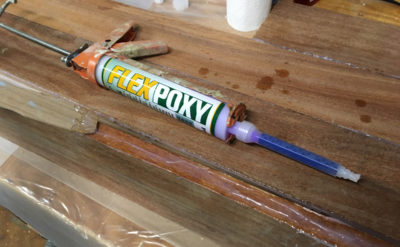
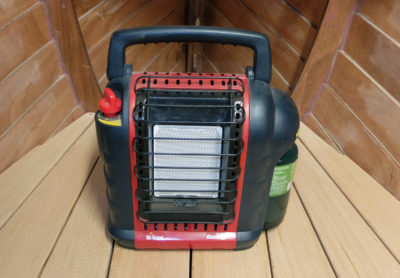
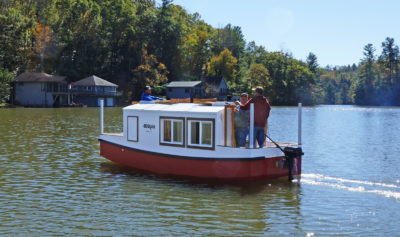
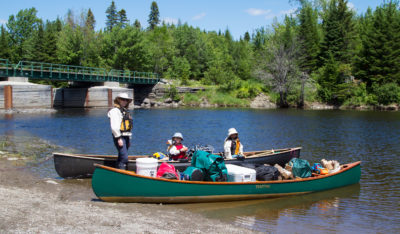
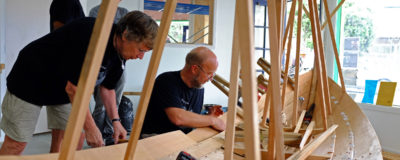
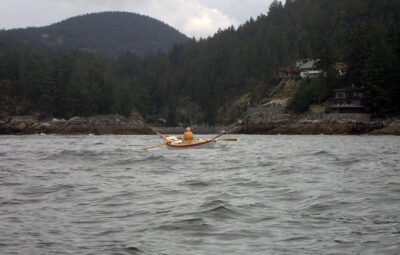
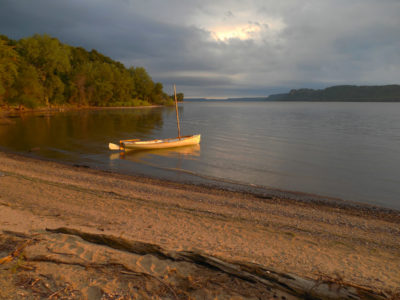
Kinda disappointed that you didn’t include a single good shot of the boat’s exterior…
Polly and Mat posted a few profile shots on their Instagram page. Click on these links:
Rowing
Planked hull
Sailing
What a great adventure—thanks so much for sharing it, Polly! On the opposite side of the world I often think of how to see France/Europe/the Med, and while the canals are obvious, doing it in a row boat wasn’t. Really enjoyed your story, thanks again.
Congratulations, Polly and Mat. A grand adventure that most of us only think about, well done for making it happen.
For those who like small-boat adventures I can highly recommend The unlikely voyage of Jack de Crow by AJ Mackinnon in which Jack de Crow, a Mirror dinghy, is sailed, rowed and towed from north Wales to the Black Sea, a distance of 4900 km by canal, river, and sea. An epic voyage told with great humor. (One of the very few books I have read multiple times). Now out of print, second-hand copies are the way to go.
The book is also available in a Kindle edition.
Fantastic, what a perfect trip for a that boat!!! Takes courage to do such a thing, no video games onboard that trip!
A fabulous tale of an awesome adventure. Well done you two! Where to next?
Loved this adventure. Thank you Polly for sharing. What a trip. You did what most of us only think or dream about. Of interest, we have been following Impetuous Too on their blog and Facebook for three years. Their worldly travels in a sail boat have been wonderful as we feel we are often with them. Over the past two years they have added two babies. Really amazing…… I think you would enjoy following them. (Duncan and Ruth met about 10 years ago on a canal in Bath, England.) Thank you.
Thank you for the lovely passage. I have wanted to do this ever since I was stationed near there almost 60 years ago. One has to prioritize, however. I surely did enjoy your trip!!
Hello Polly and Mat,
Thanks a lot for your beautiful story with your small boat. In a few years I would like to go with a Drascombe from the Netherlands to Greece. I am influenced by Ken Duxbury who made with his wife Brenda a trip from Greece to the UK in an open Drascombe. I read this story 30 years ago and my wife and I had one plan: to sail in Greece with a small boat. And we did it. Have a look on our web site.
Please make more of such wonderful journeys and write about them.
As a British registered ship you could have sailed your dinghy across the Channel. French regulations apply to French vessels, not British ones.
Having spent the past eight summers on the French canals on a 21-meter Dutch barge, I was fascinated by your adventure. Good for you. And good for the French lock tenders for bending the rules to let you use the locks. We have a blog—On a barge in France: Adventures on HOOP DOET LEVEN—about cruising the French canal.
Hello,
What is the boat’s design? Are plans out there?